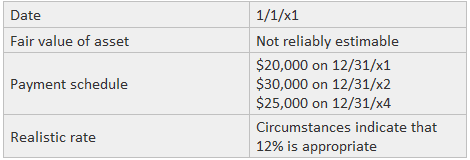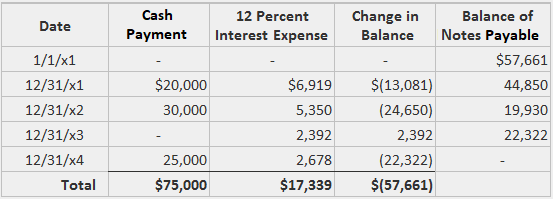Liabilities are generally recorded and disclosed at the present value of the future payments, computed using a realistic interest rate. The existence of a nominal interest rate that is unrealistic makes the measurement task more difficult. The effect of complying with this rule is a description of the proper relationship between the amount actually borrowed and the amount of interest incurred during the life of the liability. As an example of the use of present value calculations, consider the following facts about the acquisition of an asset: The amount of debt is as follows: The following entry would be made at the time of purchase: The journal entry below would be recorded on 31 December 20x1, when the first payment is made. The balance sheet would report the note balance of $44,580 on 31 December 20x1. The following example shows the calculation of the annual interest expense and the amount that would be disclosed for the note Change in Balance. An alternate approach to recordkeeping would have recognized the difference between the present value of the note ($57,661) and the sum of the future payments ($75,000) as a discount of $17,339. Then, subsequent entries would have credited the discount instead of the note payable. While GAAP calls for disclosure of the amount of the discount, it need not be recorded formally in the accounts. However, as a practical matter, recording the discount would virtually assure its disclosure in the balance sheet. As exceptions to this general treatment, GAAP does not require that present value measurements be applied to trade receivables or payables due within "approximately one year" or to deposits that are to be applied to the purchase or sale of goods. The apparent reason for the exceptions is the probable immateriality of the amounts.Example





Measuring and Recording Liabilities FAQs
Liabilities are recorded at their face amount (i.e., principal) when they can be paid in full by using existing resources legally available to the entity; thus, no premium is required for bearing this risk. Also, assuming no extraordinary or unusual circumstances exist, liabilities must not be recorded at more than the amount payable in exchange for goods or services received.
Liabilities are recorded at their present value, if necessary, to reflect future economic benefits to be derived from incurring the obligation and any related allocation of the discount between interest expense and accretion of a discount on an asset.
A note payable is deemed to have been issued with fixed terms if its original issuance does not provide for conversion into common stock or other equity securities. If conversion is allowed, the terms are deemed to be variable, since the holder could convert at any time after issuance of the note.
If a contingent liability is not recognized because it is regarded as remote, no disclosure should be made about it. However, if it is probable that a loss has been incurred at the date of the Financial Statements and it can be reasonably estimated, an appropriate disclosure in the footnotes to the Financial Statements should be made.
Litigation is probable if, based on a recent review of similar actions involving similarly situated parties, the entity's management believes that there is a good chance that litigation has been filed or will be filed within a short time. The amount to be paid as a result of such litigation should not be recognized until it can be reasonably estimated.
True Tamplin is a published author, public speaker, CEO of UpDigital, and founder of Finance Strategists.
True is a Certified Educator in Personal Finance (CEPF®), author of The Handy Financial Ratios Guide, a member of the Society for Advancing Business Editing and Writing, contributes to his financial education site, Finance Strategists, and has spoken to various financial communities such as the CFA Institute, as well as university students like his Alma mater, Biola University, where he received a bachelor of science in business and data analytics.
To learn more about True, visit his personal website or view his author profiles on Amazon, Nasdaq and Forbes.











